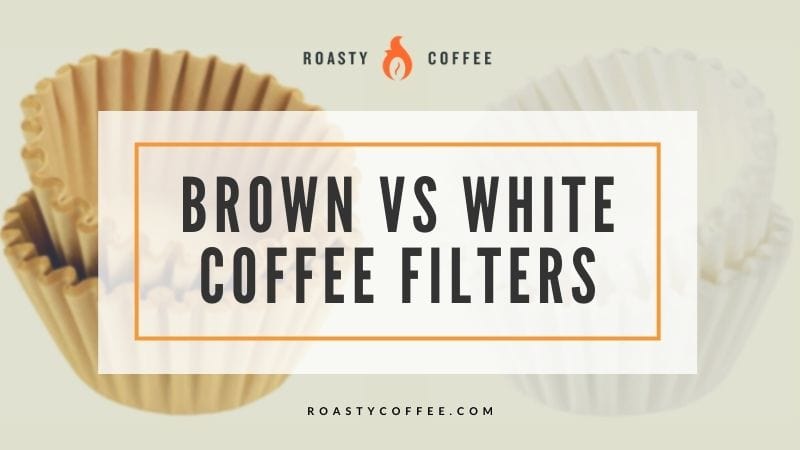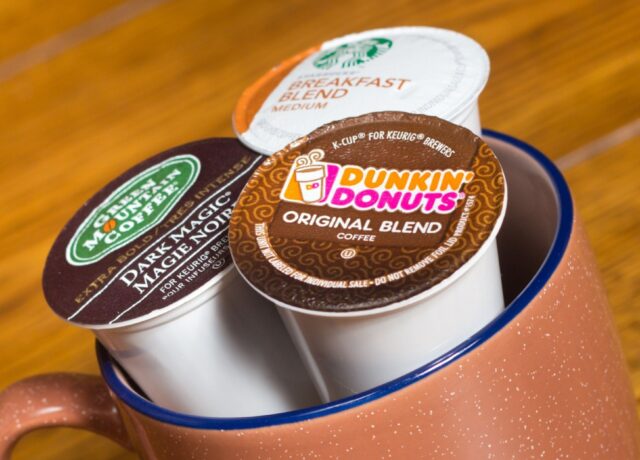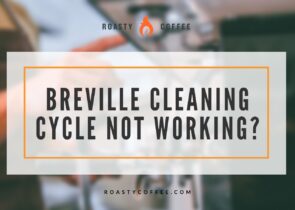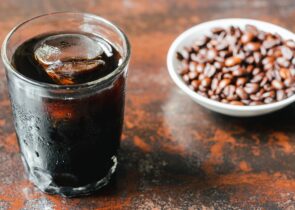If you’ve shopped for coffee filters lately, you’ve probably noticed two types of paper filters on the shelves: brown unbleached coffee filters and white bleached filters. Whether brown or white, coffee filters are essential for brewing coffee. They influence the outcome of a coffee brew and make a significant difference in how your coffee tastes. Learning the difference between brown vs white coffee filters can help you achieve a better coffee experience.
There’s more to consider about brown and white coffee filters, aside from their noticeable color difference. Each coffee filter can make a difference in your coffee.
There are many factors to consider that influence your coffee results. From the filter material’s size, thickness, and composition to the methods of enhancing the coffee filter, they all play a part.

Importance of Coffee Filters
The pour-over method, also known as drip coffee or filter coffee, has become popular among coffee enthusiasts. This method involves running water through coffee and filter into a mug or carafe.
Alongside this popularity, the question of what filter to use becomes pertinent. In fact, the coffee filter has a significant impact on the brew you’re going to end up with. It affects several aspects such as the aroma, mouthfeel, bitterness, and acidity of coffee.
There are actually many coffee filter types: metal, cloth, paper, basket, and cone coffee filters. However, the most common filters for your drip coffee machine are metal, cloth, and paper.
Many coffee gurus prefer paper coffee filters because they are much more refined and trap more coffee granules. As a result, the coffee tends to be brighter and lighter in color and taste.
Paper filters are very absorbent and tightly woven, filtering out many coffee sediments and oils, leaving the coffee with a thinner, clearer, and lighter brew.
Basically, there are two types of paper coffee filters: brown and white paper filters. So, let’s settle the argument of brown vs. white coffee filters and which one is better.
Brown vs White Coffee Filters
White Coffee Filters
White coffee filters are paper filters with a white exterior, achieved through two alternative bleaching methods; chlorine or oxygen bleaching (sodium percarbonate). Chlorine bleaching uses a minimal amount of chlorine that is usually not considered harmful to the body.
On the other hand, oxygen bleaching is a more eco-friendly method that uses a chlorine-free bleaching solution to whiten the exterior of the paper.
Chlorine Bleaching
In this process, chlorine is used to bleach the paper. Coffee filters made through this process are the cheapest. While some filters release additional odor or flavor in the coffee, it’s recommended to rinse the coffee filter first before use.
As much as possible, try to avoid white coffee filters whitened through chlorine bleaching. Typically, these coffee filters are lower in quality than brown coffee filters or the white ones made through oxygen bleaching.
Oxygen Bleaching
Another type of white coffee filter is made through the oxygen bleaching method. The primary bleaching agent is ‘oxygen bleach,’ also known as ‘sodium percarbonate.’ It is eco-friendly because it decomposes into water and oxygen.
Many products that use this production method can be found with names like ‘Oxywash,’ ‘Oxyclean,’ ‘Oxylife,’ and many more.
For white coffee filters, using oxygen bleach is much better because this bleaching agent isn’t particularly toxic and is good for the environment. The only downside is that coffee filters bleached with oxygen bleach are more expensive than those using chlorine.
If you prefer to use white coffee filters, look for ‘TCF’ on their labels. This mark means that the filter paper is 100% made without chlorine.
Brown Coffee Filters
Brown coffee filters, also known as unbleached paper filters, don’t have the white exterior of their bleached counterparts. They have a natural brown color and are environmentally friendly because they don’t undergo whitening through chemical bleaches such as chlorine.
Some coffee gurus detect a papery taste with brown paper filters, which they don’t experience with white filters. Thankfully, it’s relatively easy to avoid adding an unwanted flavor or odor to your coffee by following a few simple steps:
- First, place a new brown filter into the brewing basket of the coffee maker.
- Ensure your carafe is below the basket.
- Next, pour hot water into the unbleached filter and wet it entirely.
- Once thoroughly wet, discard the water.
- Repeat the process for the best taste (optional).
- Lastly, brew your coffee.
These additional steps can help you avoid that slight paper taste added to your great-tasting coffee. If you do this, it would be hard to spot the difference in coffee made from brown or white coffee filters.
Additionally, brown coffee filters have better resistance to tears and ruptures because they are not processed as much as white coffee filters that use bleach. In fact, brown coffee filters seldom tear, which is an additional advantage.
Factors to Consider When Buying Brown or White Coffee Filters
In the debate of brown vs white coffee filters, remember that the bleaching process isn’t the only difference. On top of this, there are still some factors to look out for when shopping for coffee filters:
Quality and Thickness
The quality of the coffee filter, either brown or white, plays a vital role in ensuring good brew flow and clean coffee profiles. Choosing a good quality filter can have a significant impact on your coffee.
Aside from the quality, ensure that you use a coffee filter of the proper thickness for the brewing method. Using a very thin coffee filter can result in water flowing through quickly and not extracting coffee properly. Using a thicker coffee filter can keep more oils out of your coffee.
Coffee gurus say the thicker the filter, the better. Usually, thicker filters are more expensive, but the price difference isn’t that much.
Strength
Another factor is strength, which means how much pressure the filter paper can resist before it ruptures. If you buy a filter made from low-quality materials, it will be prone to tears and ruptures.
Compatibility
Compatibility refers to the paper’s resistance to heat and chemical degradation. Look for good quality coffee filters, either white or brown, that won’t break easily when exposed to heat. Some coffee filters made with thick fibers may appear strong when touched. However, they’re entirely useless if they quickly degrade when exposed to high heat.
Capacity and Efficiency
Other essential parameters that go hand in hand are capacity and efficiency. Efficiency refers to how the coffee filter performs its job of retaining even the finest coffee particles that pass through it.
You can say that a coffee filter is very efficient if it doesn’t allow any coffee particles to go through.
Capacity is the ability of the coffee filter to hold the retained coffee particles while brewing continues. An efficient filter may have insufficient capacity if it has problems holding enough coffee particles before water can’t flow anymore.
Thus, look for a good quality coffee filter with the right balance between particle retention and flow requirements.
Environmental Impact
White coffee filters, especially those bleached with chlorine, aren’t good for the environment. The production of bleached coffee filters entails using chlorine in the manufacturing process.
When discarded, they cause environmental pollution even though they contain a minimal amount of chlorine.
Thus, between chlorine bleaching and the oxygen bleaching process, the latter is more preferred because of its natural approach.
Using a brown paper filter is much better and friendlier when discussing environmental impact. Unbleached paper coffee filters are less processed and undoubtedly present a better environmental option.
Cost
While chlorine-bleached white coffee filters are less expensive, oxygen-bleached variants and brown coffee filters are more eco-friendly. Whether you choose brown or white coffee filters, ensure that you pick only high-quality coffee filters for the best brew experience.
Should You Wet a Paper Coffee Filter?
When using an unbleached paper coffee filter, it’s recommended to rinse it once or twice before use to prevent having paper flavors in your coffee. However, there’s no need for pre-rinsing if you don’t notice any difference.
If you’re using a drip coffee maker, there’s no need to pre-wet your coffee filter as it works just fine even when the filter is dry. However, you can experiment with both to check if there’s a difference after all.
But if you’re using Chemex, V60, or a Melitta to make a pour-over coffee, you may want to pre-wet the coffee filter. If you already have the skill to use any of these, you’ll also notice slight differences, such as the papery taste of the brown coffee filter.
So, you may want to rinse the filter first to use your pour-over device properly.
Of course, there are plenty of pour-over devices available on the market. But in general, you need to wet your coffee filter first to create a seal between the coffee filter and the edge of your pour-over device. It’s one of the best ways to improve your coffee experience.
Besides, if you notice an added papery taste in your coffee from the filter, there’s no going back. So, it’s better to start rinsing your filter every time before use.
Reusing Your Coffee Filters
Many people don’t know that they can reuse their coffee filters. They can be used up to five times before losing their effectiveness. Every after use, you need to dispose of the coffee grounds. Then, rinse and dry the filter before reuse. This way, you can get the most bang for your buck.
Some people don’t want to reuse their coffee grounds because so much flavor is lost if they are brewed again. But that isn’t the case in reusing natural filters.
It’s fine as long as they’re rinsed and dried, and you’ll hardly notice a difference. On top of this, there are actually many things you can do with your used coffee filters:
- Make arts and crafts such as paper flowers, eco-collage, or lampshades
- Get plant seeds to sprout
- Cover food for microwave splatter protection
- Decorate your table and create a vintage look
- Collect kitchen grease
If you’re using white chlorine-bleached filters, there are many ways you can minimize the impact on the environment through these alternatives. Reusing them for many different things can make them a worthy investment.
Choose Quality Brown vs. White Coffee Filters
Whether brown or white coffee filters are a better choice depends primarily on environmental considerations. Either won’t affect the coffee’s flavor if added steps are performed on the unbleached ones.
Whether it’s brown or white, a coffee filter must be of the appropriate size and thickness.
Additionally, don’t settle for cheaply made coffee filters to save money. Buy good quality coffee filters instead to brew your coffee correctly. The quality is more crucial than choosing between brown or white filters as far as the coffee’s flavor is concerned.
Brown vs. White Coffee Filters: Which One Is Better?
The paper coffee filter debate boils down to one’s preference. As far as the flavor goes, it will be the same for both brown and white coffee filters as long as you wet the brown coffee filters.
But environmentally speaking, the white coffee filters bleached with chlorine are environmental polluters. Additionally, since you can’t recycle both types of coffee filters, it’s great to consider other deciding factors to help you pick which one is better.
The great news is that both brown and white coffee filters can give you that great coffee experience, so you don’t need to worry about that part. Of course, you have to use high-quality coffee filters, whether they’re brown or white.
You can research the brand name before purchasing and look for reviews to help you decide. Or you might want to buy more familiar brands to be on the safe side.
The next time you make a cup of coffee, remember that every part of the brewing process is essential: from the water to the temperature to the coffee filter to the coffee grounds and the device itself.
After all, choosing between brown and white coffee filters won’t be so hard once you know about each type.
The Better Choice For You
Always remember that the most critical aspect to remember is to ensure your white coffee filters are made using oxygen bleach, not chlorine and that your brown coffee filters are actually natural, and not just white filters dyed brown.
Now you know the differences between brown and white coffee filters. So, which is better? The answer: neither is necessarily better.
Besides, both aren’t that expensive. So, why not grab a box of each and try them for yourself? You can have fun while doing your little brewing experiments. If you’re ready to experiment, check out some of our coffee brewing methods to help you make that cup of excellent coffee.
Happy Filtering!









